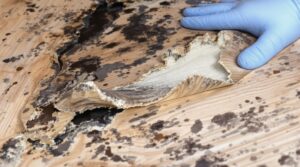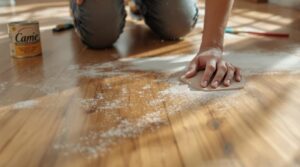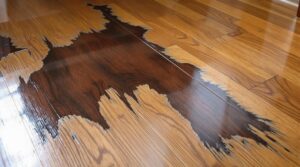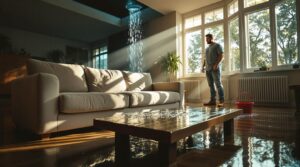Professional water damage inspections require systematic evaluation using specialized equipment like moisture meters and thermal imaging cameras. Certified inspectors follow detailed protocols to identify contamination levels, document damage through photographs, and measure moisture content in building materials. The process includes thorough visual assessments, technical measurements, and development of targeted remediation strategies. Understanding these extensive inspection methods provides essential knowledge for effective water damage assessment and restoration planning.
Key Takeaways
- Always begin with a visual inspection for water stains, discoloration, peeling paint, and musty odors to identify damage locations.
- Use moisture meters and thermal imaging cameras to detect hidden water damage and measure moisture content in materials.
- Document all findings through detailed photographs, moisture readings, and inspection notes for insurance claims and restoration planning.
- Determine water contamination category (clean, gray, or black) to establish appropriate safety protocols and cleanup procedures.
- Create moisture maps and establish baseline readings to track drying progress and develop effective remediation strategies.
Understanding the Warning Signs of Water Damage
When it comes to protecting a property from water-related issues, understanding the warning signs of water damage is essential for early detection and prevention of costly repairs.
Basic home inspection tips focus on identifying both visible and concealed indicators of water infiltration throughout the structure.
Visual indicators include water stains on walls and ceilings, discoloration of surfaces, and accumulation of water in unexpected areas.
Moisture-related issues often manifest through peeling paint, bubbling wallpaper, and warped wooden components.
For effective water damage prevention, property owners should monitor for musty odors, which can signal hidden moisture problems, and inspect for soft spots in floors or walls that may indicate structural compromise.
Key areas requiring particular attention include spaces around windows and doors, basements, attics, and areas surrounding plumbing fixtures.
Regular examination of these vulnerable locations helps identify potential problems before they escalate into significant damage.
Essential Tools for Professional Water Damage Assessment
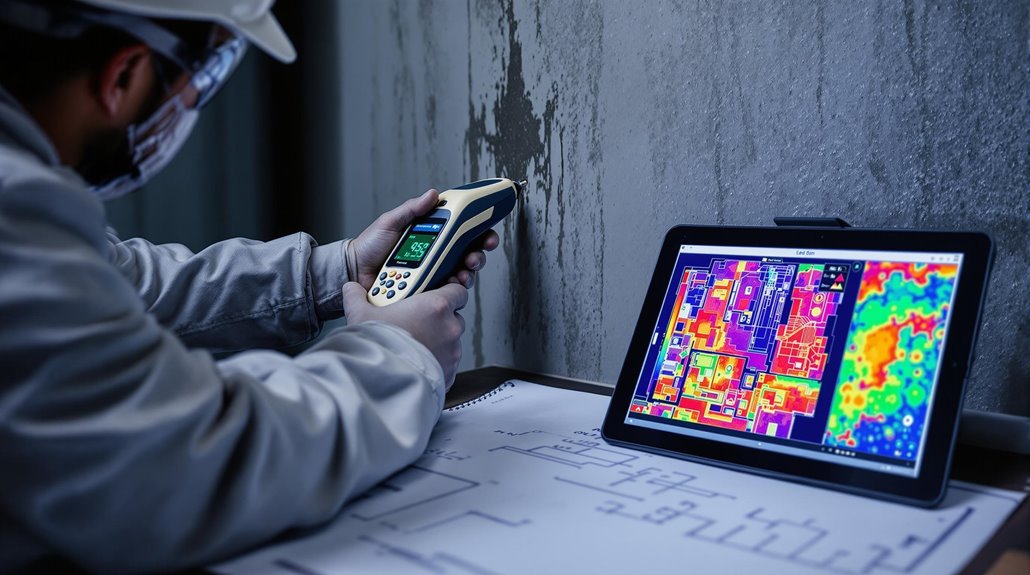
Professional water damage assessments rely on sophisticated moisture detection equipment, including calibrated moisture meters and digital hygrometers that provide precise measurements of water intrusion levels.
Advanced thermal imaging tools enhance inspection capabilities by revealing hidden moisture patterns and temperature variations within building materials through non-invasive scanning methods.
Diagnostic documentation systems, incorporating floor plan applications and digital reporting tools, enable inspectors to create thorough records of moisture readings, damage patterns, and remediation requirements.
Moisture Detection Equipment Explained
Modern moisture detection equipment serves as the cornerstone of professional water damage assessment, enabling inspectors to identify, measure, and document water intrusion with precision. Recent moisture detection innovations integrate multiple technologies to provide thorough data collection and analysis capabilities.
| Equipment Type | Primary Function | Key Benefits |
|---|---|---|
| Moisture Meters | Measures solid material moisture content | Accurate subsurface readings |
| Thermo-Hygrometers | Tests ambient conditions and dew point | Extensive environmental data |
| Moisture Mapping Tools | Documents moisture spread patterns | Visual representation of damage |
These moisture assessment techniques employ specialized instruments that work in conjunction to create detailed profiles of affected areas. Moisture meters quantify water content in building materials, while thermo-hygrometers monitor atmospheric conditions. Advanced mapping systems then synthesize this data to generate thorough moisture distribution patterns, essential for developing targeted restoration strategies.
Advanced Thermal Imaging Tools
Advanced thermal imaging tools represent a cornerstone technology in water damage assessment, utilizing infrared radiation detection to create detailed temperature-based visualizations of affected areas.
These thermal imaging advancements enable non-destructive inspection of surfaces, detecting temperature variations that indicate moisture presence behind walls, under floors, and within ceilings.
Modern infrared technology applications combine thermal imaging with moisture meters, exemplified by devices like the FLIR MR176, which integrate multiple measurement capabilities.
These sophisticated tools feature field-replaceable sensors for temperature and relative humidity readings, customizable color palettes, and lock-image settings to prevent measurement distortion.
The technology proves invaluable in post-disaster scenarios, accelerating damage assessment, verifying drying effectiveness, and ensuring thorough restoration while minimizing unnecessary repairs and associated costs.
Diagnostic Documentation Systems
Thorough diagnostic documentation systems form the backbone of professional water damage assessment, combining multiple specialized tools and software solutions to create detailed, verifiable records of damage conditions.
Modern diagnostic software integrates data from moisture meters, thermo-hygrometers, and infrared imaging to generate extensive reports. These systems enhance documentation efficiency through digital floor plans, customizable forms, and seamless integration with industry-standard estimating platforms.
- Digital moisture readings and thermal images provide quantifiable evidence of water intrusion patterns
- Customizable documentation forms guarantee consistent data collection across multiple inspection points
- Integration with estimating tools streamlines workflow and reduces transcription errors while maintaining IICRC compliance standards
Step-by-Step Property Inspection Process
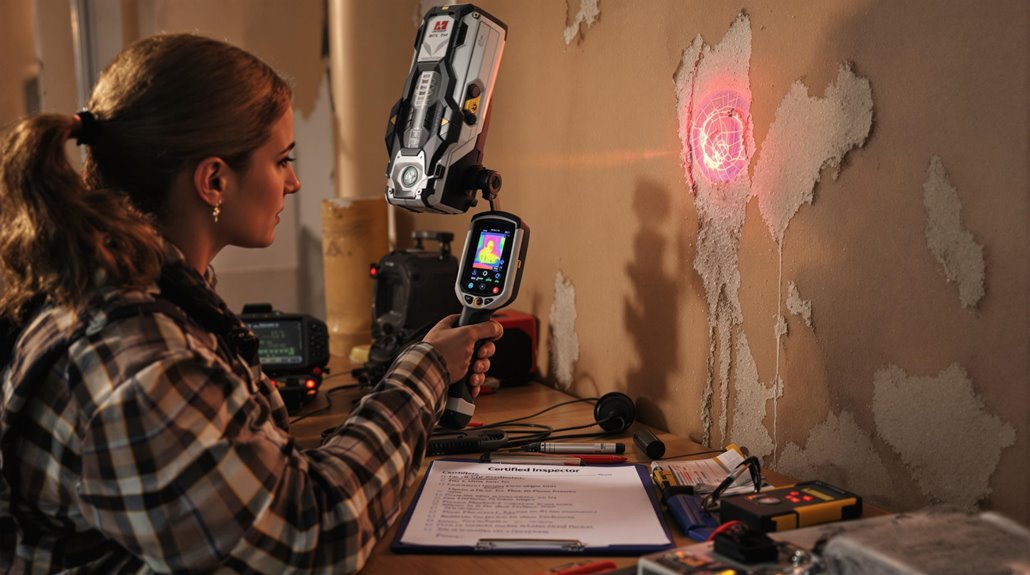
A thorough water damage inspection requires careful planning and systematic execution across multiple phases to guarantee accurate assessment of affected properties. The process begins with selecting a certified inspector who maintains an extensive inspection checklist and possesses advanced moisture detection equipment. This preliminary phase emphasizes damage prevention through prompt scheduling and proper preparation.
The inspection proceeds through distinct stages, starting with visual assessment to identify apparent damage indicators, followed by technical measurements using moisture meters and thermal imaging cameras. Inspectors systematically evaluate walls, floors, ceilings, and concealed spaces while documenting findings through photographs and detailed notes.
They assess air quality and structural integrity, measuring relative humidity levels throughout the property.
The final phase involves compiling detailed documentation, including moisture readings, photographic evidence, and specific recommendations for remediation. This documentation serves as the foundation for developing targeted restoration strategies and supporting insurance claims.
Classifying Water Contamination Levels
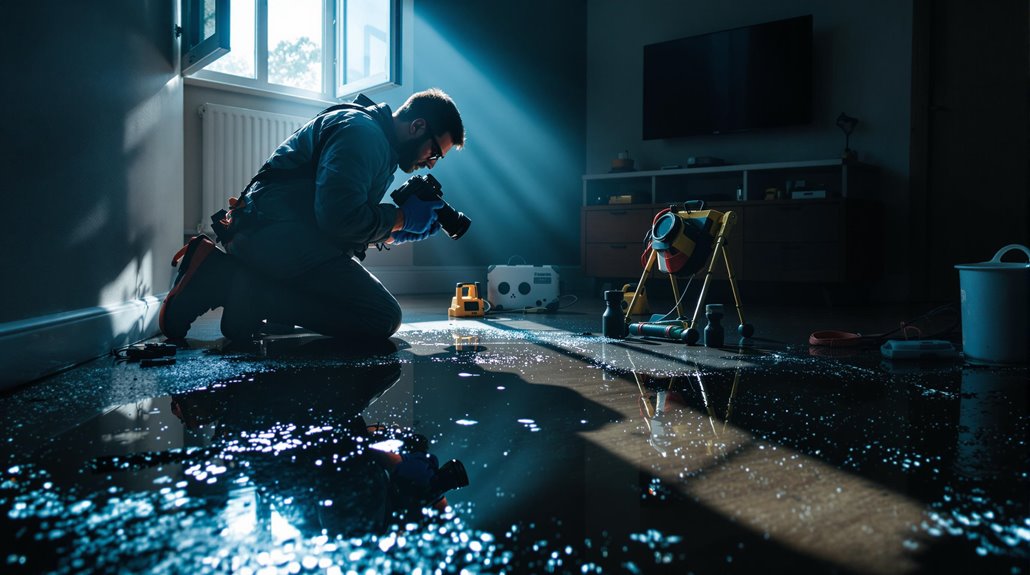
Water damage inspectors must classify contamination into three distinct categories: Category 1 (clean water), Category 2 (gray water), and Category 3 (black water).
Testing procedures require careful examination of contamination sources, including broken supply lines, sewage backups, chemical spills, and hazardous materials.
Each category demands specific mitigation protocols, with Category 1 requiring basic drying methods, Category 2 needing decontamination procedures, and Category 3 demanding specialized hazardous material cleanup techniques.
Water Categories Overview
Professional restoration experts classify water damage into three distinct categories based on contamination levels and associated health risks.
Category 1 involves sanitary water from clean sources, requiring basic water safety measures during cleanup.
Category 2 contains significant contamination from sources like dishwasher overflow, demanding stricter contamination prevention protocols.
Category 3 represents grossly contaminated water containing harmful pathogens, typically from sewage or flood sources.
- Proper category identification determines the necessary safety equipment, cleanup procedures, and material disposal requirements.
- Time and temperature can escalate lower categories to more severe contamination levels.
- Professional assessment is essential for accurate categorization and appropriate mitigation strategies.
Restoration professionals must follow ANSI/IICRC S500 standards when evaluating and treating water damage, ensuring safe and effective remediation processes.
Testing Contamination Sources
To accurately classify water contamination levels, restoration experts employ a systematic testing approach that combines visual inspection, physical assessment, and laboratory analysis. Each contamination source requires specific evaluation methods to determine its category and associated risks.
Laboratory testing examines water quality through three primary methods: physical tests evaluate properties like turbidity and conductivity; chemical tests assess parameters including pH levels and chemical compounds; and biological tests identify the presence of harmful microorganisms.
This thorough analysis helps categorize water damage into three distinct levels: Category 1 (clean water from sanitary sources), Category 2 (significantly contaminated water posing health risks), and Category 3 (severely contaminated water containing hazardous materials).
Understanding contamination sources through proper testing guarantees appropriate mitigation strategies are implemented.
Measuring and Documenting Moisture Content
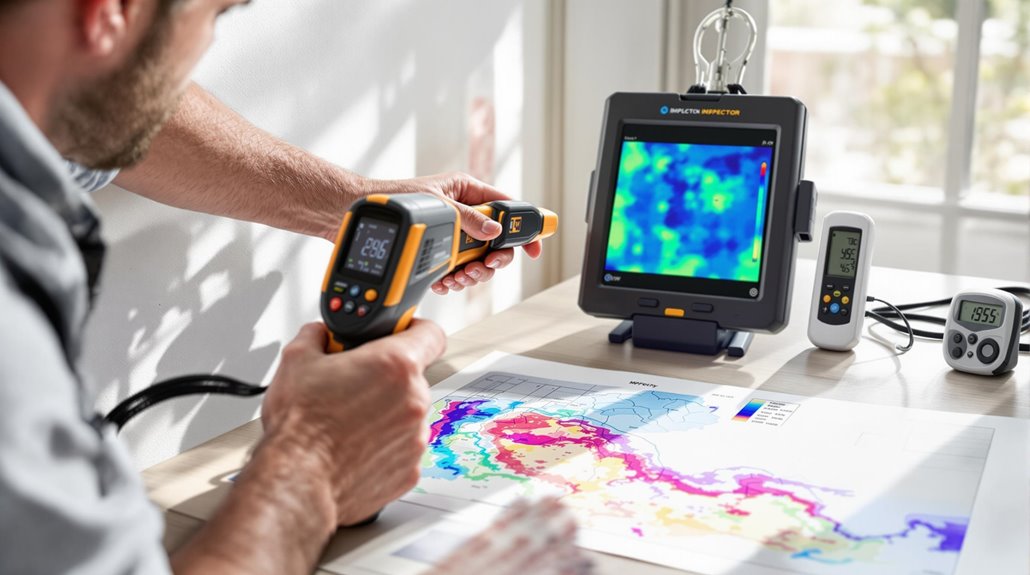
Accurate measurement and documentation of moisture content forms the foundation of effective water damage assessment.
Professional inspectors employ multiple methods to evaluate moisture retention and guarantee measurement accuracy, including pin-type moisture meters for detailed readings and non-invasive meters for broad surface evaluations.
Infrared thermal imaging provides additional insights by detecting temperature variations that indicate moisture presence.
Systematic documentation through moisture mapping creates extensive visual representations of affected areas, while comparative analysis against unaffected materials establishes essential baseline readings.
These measurements inform restoration strategies and support insurance claims.
- Primary measurement techniques include Loss on Drying (LOD), Karl Fischer Titration, and Thermo Gravimetric analysis for precise moisture content determination.
- Environmental conditions must be recorded using thermo hygrometers to contextualize moisture readings.
- Regular monitoring intervals should be established to track drying progress and adjust remediation strategies accordingly.
Evaluating Structural Impact and Safety Concerns
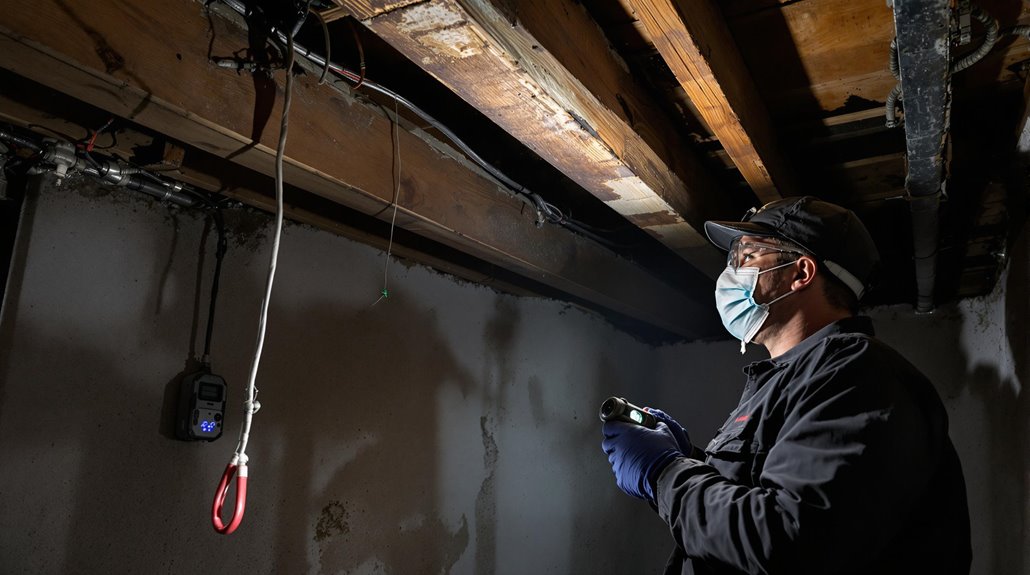
Water damage assessment extends beyond moisture measurements to encompass thorough structural evaluation and safety protocols. Professionals conduct visual assessments to identify visible damage signs, including material deterioration, staining, and structural weakening, ranking severity to prioritize repairs. They also utilize advanced technologies, such as infrared cameras and moisture meters, to detect hidden moisture pockets that may not be visible to the naked eye. Additionally, assessing for signs of water damage in tiles can reveal serious underlying issues that may compromise the integrity of the flooring. By systematically addressing both apparent and concealed damage, professionals can develop a comprehensive restoration plan tailored to the specific needs of the affected area.
The inspection process evaluates load-bearing capabilities and potential structural compromises that could affect building integrity.
Safety protocols require careful attention to multiple hazards during the assessment process. Inspectors must identify electrical risks from exposed wiring, recognize potential slip hazards, and evaluate air quality concerns in confined spaces.
Professional evaluations often necessitate specialized expertise, particularly from structural engineers and electricians who can provide detailed analysis and repair recommendations. The use of protective equipment, including masks, gloves, and goggles, remains essential throughout the inspection process.
Detailed documentation of findings enables accurate restoration planning while ensuring all safety concerns receive proper attention during remediation efforts.
Advanced Detection Methods for Hidden Water Damage
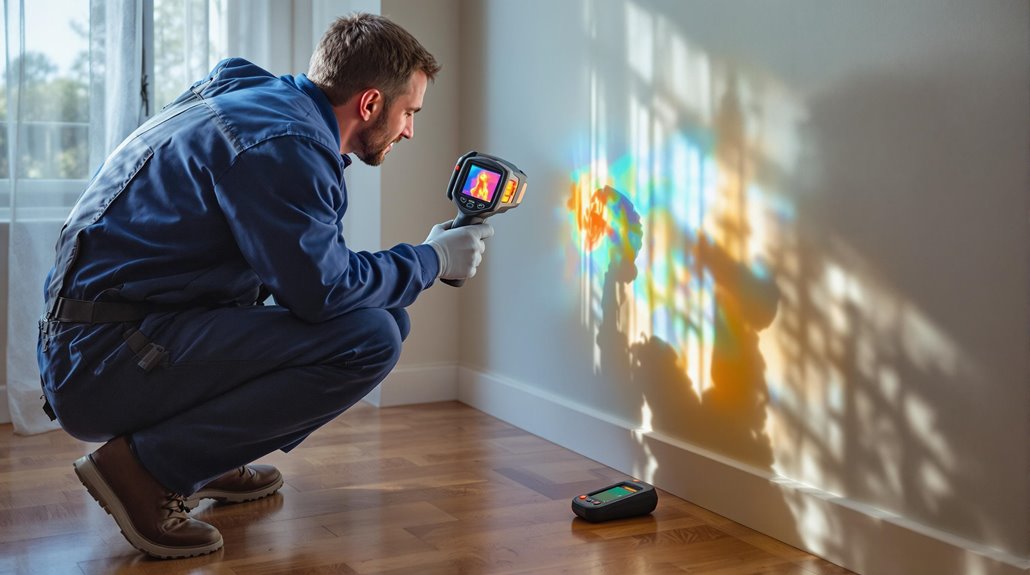
Modern detection methods employ sophisticated technology to identify concealed water damage that might otherwise remain undetected during visual inspections.
Advanced moisture detection tools include thermal imaging cameras that reveal temperature variations caused by water intrusion, moisture meters that measure content levels in building materials, and endoscopes equipped with cameras for examining concealed spaces.
For effective leak identification, professionals utilize ultrasonic and acoustic detection systems that identify water intrusion through sound wave analysis, while Ground Penetrating Radar and LiDAR technologies map structural changes indicating water damage patterns.
- Moisture meters require regular calibration and skilled operation to provide accurate readings of water content in different building materials.
- Thermal imaging cameras detect temperature differentials, enabling rapid scanning of large areas for thorough damage assessment.
- Endoscopic inspection tools allow precise visual examination of wall cavities and other confined spaces without destructive investigation methods.
Creating a Detailed Assessment Report
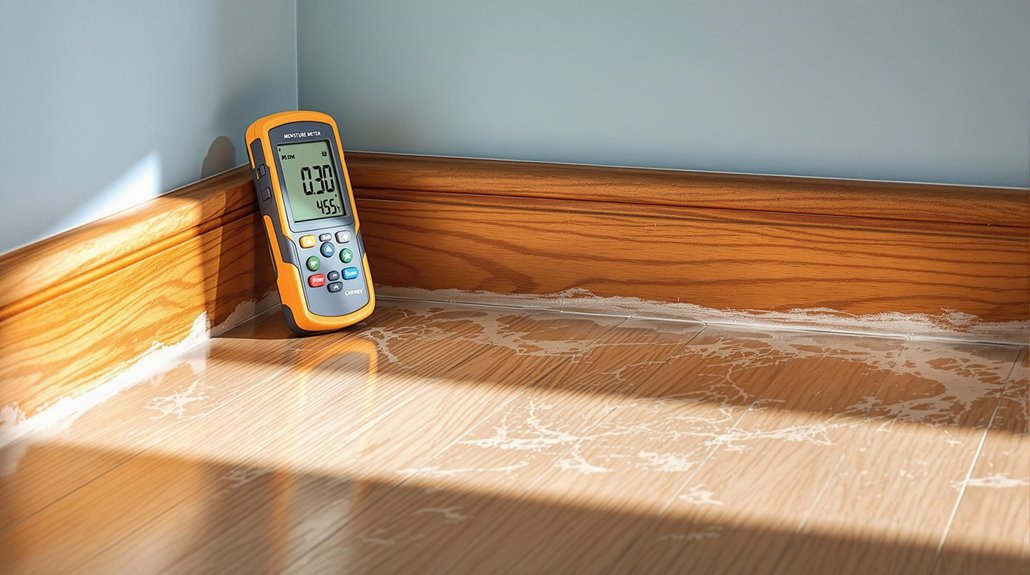
A thorough water damage assessment report requires systematic documentation of moisture testing results using digital meters and hygrometers to establish precise measurements throughout affected areas.
Visual evidence must be thoroughly cataloged through annotated photographs and detailed notes describing observable damage to materials and structures.
The report should include analysis of potential hidden problems in wall cavities, subfloors, and other concealed spaces where water migration may have occurred but is not immediately visible.
Document Moisture Testing Results
Creating detailed moisture testing documentation represents a critical component of water damage assessments, requiring systematic data collection and precise reporting methods. Technicians utilize various tools, including digital moisture meters and hygrometers, to measure moisture retention and establish testing frequency protocols.
The documentation process incorporates thorough moisture maps, environmental conditions, and specific readings from affected materials.
- Record moisture levels using standardized forms, capturing data from walls, ceilings, and floors with precise measurements from digital moisture meters.
- Generate color-coded moisture maps to visualize affected areas, indicating severity levels and potential spread patterns.
- Document environmental conditions, including temperature, relative humidity, and dew point measurements, to establish baseline data for restoration planning.
This systematic approach guarantees accurate tracking of moisture patterns and supports effective restoration strategies while providing essential documentation for insurance claims.
Record Visual Damage Evidence
While moisture testing provides quantitative data, extensive visual documentation serves as the cornerstone of water damage assessment reporting. Photo documentation must include annotated photographs capturing key elements such as damaged flooring, furniture, appliances, and potential electrical hazards. This visual evidence supports insurance claims and helps identify immediate risks requiring attention.
Professional damage assessment requires systematic documentation using specialized tools like magicplan and integration with estimating software such as Xactimate. The process includes creating detailed floor plans, maintaining a thorough inventory of damaged items, and recording property condition notes.
Visual inspection findings, combined with data from thermal cameras and moisture meters, enable restoration professionals to develop targeted repair recommendations and prioritize tasks effectively. This methodical approach guarantees accurate assessment reports that meet insurance and legal requirements.
Analyze Hidden Problem Areas
Professional water damage assessments require systematic analysis of hidden moisture problems using specialized detection equipment and methodical documentation protocols.
Through hidden leak detection techniques and moisture retention analysis, inspectors employ calibrated meters, thermal imaging, and structural examination to identify concealed water intrusion.
Documentation of findings includes precise moisture readings, photographic evidence, and detailed assessment reports for insurance and restoration planning.
- Utilize both pinless and pin electrode moisture meters to measure electromagnetic resistance and obtain direct readings of affected materials.
- Document structural indicators including warping, bowing, soft spots, and unusual sounds that signal hidden moisture issues.
- Create thorough reports detailing moisture levels, compromised areas, and recommended restoration procedures based on scientific measurements and professional observations.
Developing an Effective Remediation Strategy
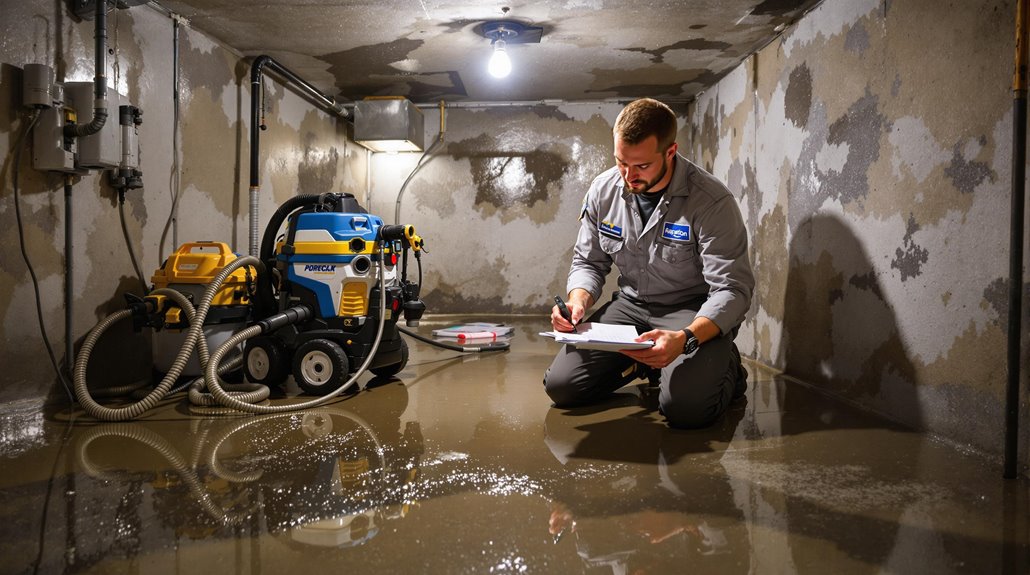
As water damage incidents require swift and methodical intervention, developing an effective remediation strategy begins with a thorough assessment framework that guides the entire restoration process. The framework encompasses characterization of contamination extent, implementation of remediation techniques, and development of containment protocols to prevent further damage.
The strategy involves multiple coordinated phases, starting with immediate water extraction using specialized equipment and establishing temporary protective measures.
Decontamination procedures follow, incorporating appropriate water treatment methods and infrastructure repairs. The clearance phase utilizes systematic sampling and data analysis to verify remediation effectiveness.
Throughout the process, detailed documentation through photographs, moisture readings, and detailed reports supports insurance claims while ensuring accountability.
This systematic approach enables restoration professionals to address both visible and hidden damage while implementing contamination prevention measures that protect occupants and preserve structural integrity.
The strategy remains flexible to accommodate varying degrees of water damage and specific site conditions.
Professional Certification and Equipment Requirements
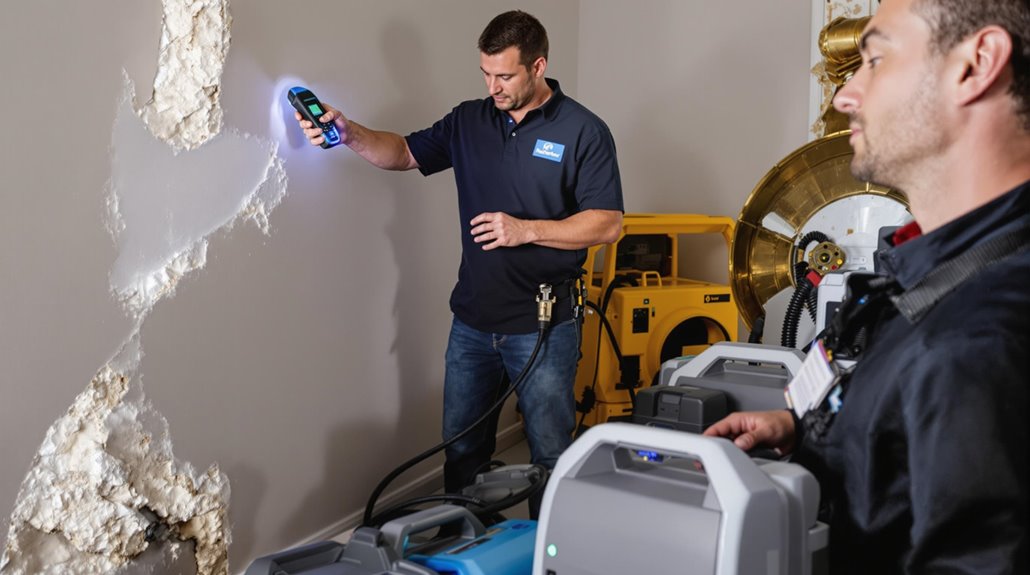
Successful water damage inspection and remediation requires specific professional certifications and specialized equipment to guarantee thorough assessment and effective restoration. The Water Damage Restoration Technician (WRT) certification, combined with proper education and annual renewals through CEUs, provides professionals with essential expertise.
Equipment innovations have enhanced inspection capabilities through advanced moisture meters, extractors, and air management systems.
- Certification benefits include validated expertise, professional credibility, and ongoing education through annual renewals.
- Modern inspection equipment enables precise moisture detection, efficient water extraction, and advanced air quality control.
- Documentation tools and software facilitate extensive assessment reporting and evidence collection.
The integration of professional credentials and cutting-edge equipment creates a systematic approach to water damage assessment.
Moisture meters detect hidden damage, while air movers and dehumidifiers facilitate the drying process.
Professionals must maintain certifications and stay current with equipment innovations to deliver ideal inspection and restoration services.
The Benefits Of Consulting A Public Adjuster
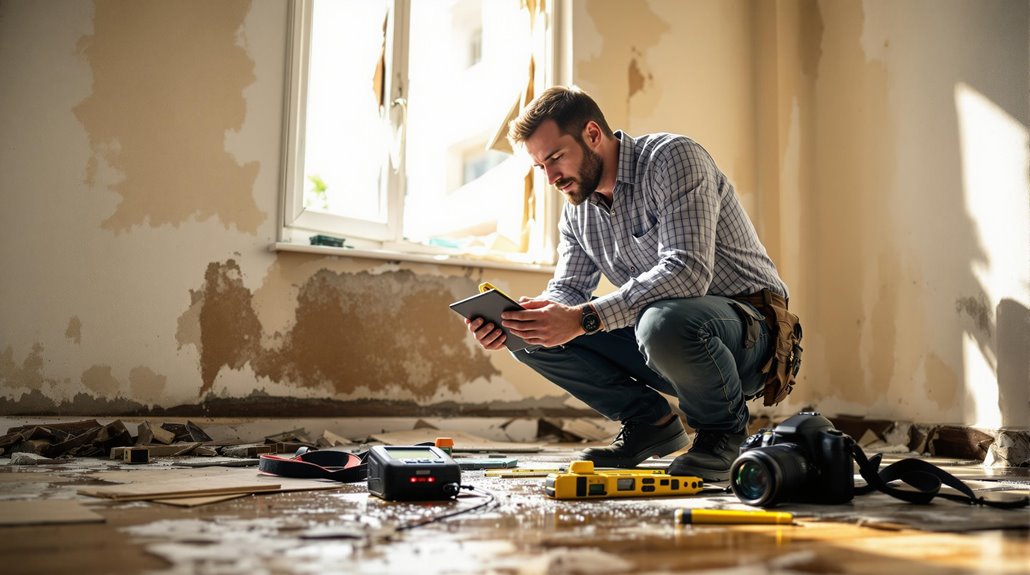
Consulting a public adjuster for water damage claims provides access to specialized expertise in insurance policy interpretation and detailed damage assessment protocols.
Professional public adjusters employ advanced documentation methods and leverage their extensive knowledge of claims procedures to navigate the complex settlement process efficiently.
Their objective evaluation methods and proven negotiation strategies consistently result in more thorough damage assessments and statistically higher claim settlements for property owners.
Expertise In Insurance Claims
When water damage strikes a property, enlisting the expertise of a public adjuster can greatly enhance the insurance claims process and final settlement outcomes. Their extensive understanding of insurance policy interpretation and claims negotiation strategies enables them to maximize settlements while ensuring compliance with regulatory requirements.
Public adjusters leverage their professional knowledge to navigate complex policy terms and advocate effectively for policyholder interests.
- They possess in-depth understanding of insurance policies, enabling accurate interpretation of coverage terms and entitled benefits.
- Their expertise includes thorough documentation practices, gathering essential evidence and proof of loss materials.
- They employ strategic negotiation techniques, countering insurance company tactics while maintaining professional representation.
These specialists work on a contingency basis, typically charging a percentage of the final settlement, eliminating upfront costs for property owners.
Objective Damage Assessment
A fundamental component of water damage claims lies in conducting objective damage assessments, where public adjusters employ advanced diagnostic tools and systematic inspection protocols to evaluate property damage thoroughly.
Using moisture meters, thermal imaging equipment, and specialized documentation forms, adjusters create detailed reports detailing both visible and concealed water damage. This unbiased approach encompasses thorough inventories of affected areas, including structural components, furniture, and appliances.
The damage assessment process incorporates precise moisture level measurements, photographic evidence, and annotated documentation to establish an accurate representation of the property's condition. This methodical evaluation guarantees that all damage is properly identified and documented, providing a solid foundation for insurance claims negotiations and establishing appropriate compensation levels for necessary repairs and replacements.
Streamlined Claim Process
Public adjusters streamline the water damage claims process through three essential services: thorough documentation, expert navigation of procedures, and dedicated policyholder advocacy. Their streamlined documentation protocols guarantee extensive records of damage while efficient communication channels facilitate swift interactions with insurance companies. This professional approach considerably reduces processing time and potential disputes.
- Extensive documentation includes detailed photos, videos, and written assessments that strengthen claims and expedite approvals.
- Expert claims navigation eliminates common procedural delays through proper filing and timely responses to insurer requests.
- Dedicated advocacy protects policyholder interests through skilled negotiation and thorough understanding of policy terms.
This systematic approach allows property owners to focus on restoration while the adjuster manages the complex claims process, ultimately leading to faster claim resolution and fair compensation.
Higher Claim Payouts & Settlements
Professional representation by licensed public adjusters greatly increases claim payouts and settlements for water damage cases through extensive damage assessments, expert negotiation skills, and detailed policy interpretation.
Using advanced tools and specialized expertise, public adjusters identify both visible and concealed water damage, ensuring thorough documentation of all affected areas.
Their claim negotiation strategies counter low settlement offers while protecting policyholder rights throughout the process. By accurately interpreting insurance policies and maintaining effective communication with insurers, they secure maximum compensation for their clients.
Public adjusters' meticulous approach to damage assessment, combined with their understanding of restoration costs and industry standards, enables them to build strong cases that justify higher settlements.
Their professional advocacy helps expedite claim resolution while preventing common underpayment issues that often occur when policyholders handle claims independently.
About The Public Claims Adjusters Network (PCAN)
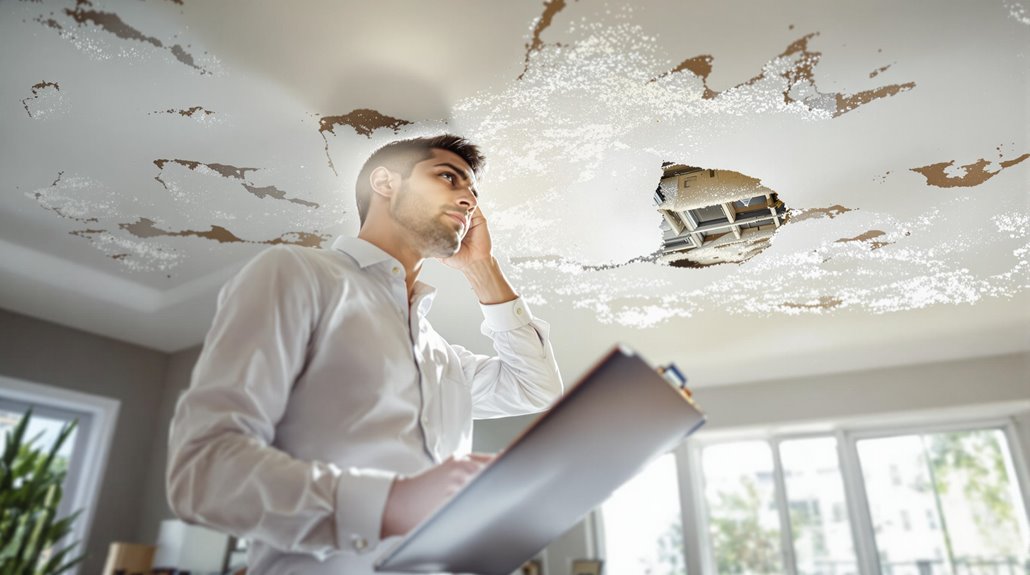
Insurance specialists within the Public Claims Adjusters Network (PCAN) serve as dedicated advocates for policyholders during property damage claims. These licensed professionals evaluate coverage, prepare detailed documentation, and implement effective claim negotiation strategies to maximize settlements.
Public adjuster benefits include elimination of conflicts of interest and expert representation throughout the claims process.
PCAN members must adhere to strict regulatory requirements, including:
- Obtaining signed, state-approved contracts before commencing work
- Providing transparent fee disclosure based on claim payment percentages
- Notifying insurers of representation within two business days
These adjusters investigate coverage parameters, interpret policy language, and handle all communications with insurance carriers. Their expertise guarantees compliance with legal requirements while expediting the claims process.
Through detailed loss documentation and professional negotiation, PCAN members protect policyholder interests and work to secure best claim settlements for water damage and related property losses.
Frequently Asked Questions
How Long Should I Wait After Water Damage Before Repainting Affected Walls?
Proper drying time before repainting water-damaged walls requires 1-2 weeks minimum, with moisture levels below 12% confirmed by meter readings before applying primers and appropriate paint types.
Can I Claim Water Damage if My Neighbor's Plumbing Caused the Problem?
While natural water flow issues may not qualify, plumbing failures typically establish neighbor liability. Property owners can pursue claims through insurance coverage or legal channels when neighbor's faulty plumbing causes damage.
Will My Insurance Rates Increase if I File a Water Damage Claim?
Filing a water damage claim typically results in premium increases ranging from 7-10%. The insurance claim impact varies by carrier, claim history, and specific water damage coverage parameters.
How Often Should Homeowners Conduct Preventive Water Damage Inspections?
Homeowners should implement preventive measures through annual professional inspections, with increased inspection frequency for high-risk areas. Monthly self-checks and seasonal assessments enhance early detection of potential water damage issues.
What Percentage of Water Damage Repairs Can Be Handled Through DIY Methods?
Approximately 15-20% of water damage cases can be addressed through DIY repair techniques, primarily Class 1 incidents, where cost-effective solutions are viable for minor, localized damage situations.


